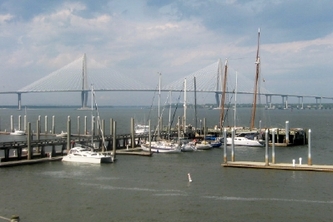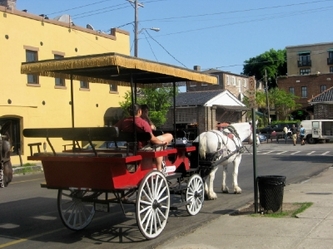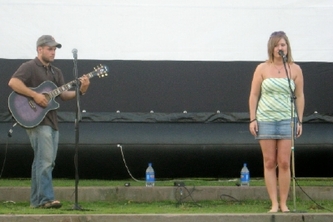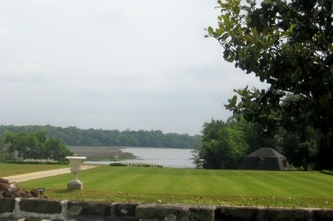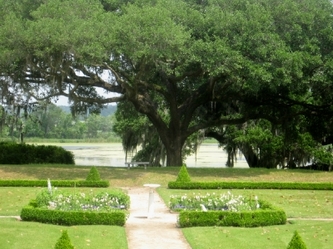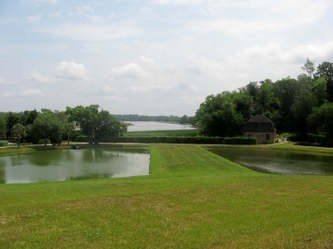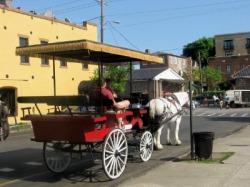
After returning from Jarratt to Charleston on Thursday, May 1st, we continued to enjoy Charleston for a couple of weeks before heading out again. Our slip had to be vacated by May 15th to make way for the Charleston Harborfest, which would begin on the 16th. This large waterfront festival is centered at the Maritime Center and would make use of all the transient slips for festival boats. As our departure date approached, we began to watch the weather and prepare ourselves and Orion to get underway again. The festival’s deadline meant that staying longer for inclement weather was not an option. We had to make sure we took whatever window presented itself.
Doing Charleston
There are a lot of reasons why Charleston is one of our favorite ports and the Maritime Center is our marina of choice.
There are a lot of reasons why Charleston is one of our favorite ports and the Maritime Center is our marina of choice.
The Charleston Maritime Center is right in the middle of things. Even before leaving the dock, you can take in the eye-popping view of the Cooper River’s commercial cargo ships, moving their goods in and out of port only yards off the dock. With a major dock just south of the marina, we are treated to a fascinating view of the business of moving cargo by ship – tugs gently nudging these city-block sized vessels 180 degrees and then docking them, cargo being unloaded and loaded, trains taking the goods away to their destinations. The Maritime Center hosts many outdoor festivities on spring weekends – weddings, corporate functions, fundraisers – that always promise to provide music and entertainment for the weekend evenings.
Beyond the marina, most of Charleston’s historic district and services are within walking distance. We made many visits to the nearby Harris Teeter and didn’t miss a Saturday morning Farmer’s Market. For entertainment, we enjoyed the free Friday night movie in Market Square, wondered down King and Market Streets, enjoying the many praline samples, and enjoyed some Carolina BBQ and shrimp and grits at some local restaurants. The bus system gave us easy access to the stores outside downtown, and the all day pass has the added advantage of allowing us to ride the downtown trolleys through the historic district and along the Battery when we return from our excursions into the Charleston suburbs.

Middleton Plantation
We had spent a month in Charleston last Spring, so we weren’t as pressed to see the sights downtown, although we did enjoy a carriage ride around the historic district. We instead took a trip up the Ashley River (by city bus, not boat), heading out to see one of Charleston’s plantations, Middleton Plantation. This estate had been owned by a family which included both a signer of the Declaration of Independence and (a hundred years later) a signer of the Articles of Secession.
We had spent a month in Charleston last Spring, so we weren’t as pressed to see the sights downtown, although we did enjoy a carriage ride around the historic district. We instead took a trip up the Ashley River (by city bus, not boat), heading out to see one of Charleston’s plantations, Middleton Plantation. This estate had been owned by a family which included both a signer of the Declaration of Independence and (a hundred years later) a signer of the Articles of Secession.

The Middleton Oak, which has stood for almost a thousand years, suffered a serious blow in early April when a massive limb cracked off and threatened the stability of the tree. It is still being reinforced.
The main attraction of Middleton these days is its original formal garden landscaping dating back to the 1700’s. The plantation house, like most of its neighbors on the Ashley River, had been burned by Union armies at the end of the Civil War and only a portion re-built afterwards. That’s why the focus was on the grounds, not the structures. There were also craftspeople interpreting the various skills needed on a plantation from blacksmithing to pottery to sheep-shearing, centered in the working buildings adjacent to the slave quarters. We took a couple of guided tours on our visit – one encompassing the formal gardens and one the life of the slaves on the plantation. There were also a number of animals roaming the grounds -- goats grazing on the lawn, peacocks strutting their plumage, cattle, water buffalo, sheep and horses -- completing the pastoral setting of this magnificent river estate. It was an idyllic setting, which was made all the more pleasant by a steady breeze that kept us cool as we wondered the grounds.
This was just one more place we found in Charleston that made us want to come back.
Boat Stuff
We’ve been told that our journals are becoming more of a travelog, and less the gritty boater’s almanac we started with (well maybe gritty is bit overreaching). At any rate, this is primarily because we aren’t doing as much work on the boat as in the early days. Hence, we have less to write about. In response to this criticism, we’ll try to do more work on the boat, so that we have something to write about here for those boaters among our readers. (You don’t really think we would work harder just to please our reader, do you?)
We continue to have problems with our engine raw water strainer “losing” water as we travel at “high” rpm’s (around 2600rpm). Acting on the possibility that this was due to a clogged raw water intake, we removed the hose from the base of the raw water strainer and tried to clear any possible blockage (using the sophisticated tool of shishkebob skewers). We found nothing, and were encouraged by the water flow in the process (which, of course, had to be mopped up afterward). We hired a diver before leaving Charleston to clean Orion’s hull and thru-hulls, which the diver ensured us were clear when he was through.
And, acting on a suggestion from Roger on Shango, Dave replaced the impeller just before we headed out for a potentially long run at sea. Sure enough, the impeller had a part of a blade missing, so he was hopeful that this might be a source of the problem. However, we wouldn’t know for sure until we put it to the test. One bad thing about our old impeller having a missing blade is that it begs the question, “where did the missing piece go?” Due diligence would require a more thorough dissection of the engine than we had time to pursue. (Also, Dave was suffering from a kidney stone that was making this more of a challenge.) So, we limited our maintenance to the change in impeller. We tested the engine after the change, running it in gear up to 3000 rpm’s and found that the water level stayed topped off. Maybe it would hold for the trip.
Having traveled a hundred hours since our last oil and fuel filter change, we were due for one by the time we reached Charleston. So we, of course, took care of these maintenance items while at the dock. Also, since we hadn’t been plugged in to shore power for more than a day in 3 months, Dave took a couple of opportunities to equalize the batteries.
Visits with Family and Friends
We had a wonderful surprise visit from Carolyn and Clint, Cathy’s sister and brother-in-law, who drove down from Sunset Beach for a day to visit us in Charleston. For supper that night, we were also joined by Deanna and Hank, Cathy’s cousins who live in Charleston. It was an unexpected family reunion, and the weather cooperated to make it a pleasant evening.
We also got a pleasant surprise when Roger and Amy on Shango arrived at the Maritime Center on Saturday (May 10th), having just returned to the US from the Exumas. They were on their way north and would be waiting out some nasty weather in Charleston before heading out again. As a result, we spent some time together catching up on each other’s winter travels (theirs went as far south as the Dominican Republic), and making plans for our respective trips north. If they aligned, we would have traveling companions.
Heading Out
We finally decided that Wednesday (May 14th) would be our departure date, with a weather window large enough to hopefully get us north as far as Beaufort, NC. If not, we would tuck in at Wrightsville Beach. This would be only a day early, so it was pretty good timing.
We left before sunrise Wednesday and made our way out the well-lit Charleston channel to sea. Amazingly, there was no large ship traffic as we left, and the conditions out in the ocean were as mild as forecast. The only disappointment was the fact that the wind didn’t pick up as forecast to allow us more help from the sails. But we made good enough time, that not only could we make Beaufort before nightfall, we could work our way into the South River (opposite Oriental), which would put us in an anchorage we knew and were comfortable with for an approaching cold front on Friday. By 6pm on Thursday afternoon, we were anchored in the South River, and settling in for a well-earned rest.
We’d come a lot farther a lot faster than we had planned, so we now had time to figure out what to do and where to go next.
One disappointing discovery on the 36 hour trip was that the raw water problem had not been eliminated. The level was dropping slightly over the course of the trip. We obviously haven’t found the true source of the problem yet.
Boat Stuff
We’ve been told that our journals are becoming more of a travelog, and less the gritty boater’s almanac we started with (well maybe gritty is bit overreaching). At any rate, this is primarily because we aren’t doing as much work on the boat as in the early days. Hence, we have less to write about. In response to this criticism, we’ll try to do more work on the boat, so that we have something to write about here for those boaters among our readers. (You don’t really think we would work harder just to please our reader, do you?)
We continue to have problems with our engine raw water strainer “losing” water as we travel at “high” rpm’s (around 2600rpm). Acting on the possibility that this was due to a clogged raw water intake, we removed the hose from the base of the raw water strainer and tried to clear any possible blockage (using the sophisticated tool of shishkebob skewers). We found nothing, and were encouraged by the water flow in the process (which, of course, had to be mopped up afterward). We hired a diver before leaving Charleston to clean Orion’s hull and thru-hulls, which the diver ensured us were clear when he was through.
And, acting on a suggestion from Roger on Shango, Dave replaced the impeller just before we headed out for a potentially long run at sea. Sure enough, the impeller had a part of a blade missing, so he was hopeful that this might be a source of the problem. However, we wouldn’t know for sure until we put it to the test. One bad thing about our old impeller having a missing blade is that it begs the question, “where did the missing piece go?” Due diligence would require a more thorough dissection of the engine than we had time to pursue. (Also, Dave was suffering from a kidney stone that was making this more of a challenge.) So, we limited our maintenance to the change in impeller. We tested the engine after the change, running it in gear up to 3000 rpm’s and found that the water level stayed topped off. Maybe it would hold for the trip.
Having traveled a hundred hours since our last oil and fuel filter change, we were due for one by the time we reached Charleston. So we, of course, took care of these maintenance items while at the dock. Also, since we hadn’t been plugged in to shore power for more than a day in 3 months, Dave took a couple of opportunities to equalize the batteries.
Visits with Family and Friends
We had a wonderful surprise visit from Carolyn and Clint, Cathy’s sister and brother-in-law, who drove down from Sunset Beach for a day to visit us in Charleston. For supper that night, we were also joined by Deanna and Hank, Cathy’s cousins who live in Charleston. It was an unexpected family reunion, and the weather cooperated to make it a pleasant evening.
We also got a pleasant surprise when Roger and Amy on Shango arrived at the Maritime Center on Saturday (May 10th), having just returned to the US from the Exumas. They were on their way north and would be waiting out some nasty weather in Charleston before heading out again. As a result, we spent some time together catching up on each other’s winter travels (theirs went as far south as the Dominican Republic), and making plans for our respective trips north. If they aligned, we would have traveling companions.
Heading Out
We finally decided that Wednesday (May 14th) would be our departure date, with a weather window large enough to hopefully get us north as far as Beaufort, NC. If not, we would tuck in at Wrightsville Beach. This would be only a day early, so it was pretty good timing.
We left before sunrise Wednesday and made our way out the well-lit Charleston channel to sea. Amazingly, there was no large ship traffic as we left, and the conditions out in the ocean were as mild as forecast. The only disappointment was the fact that the wind didn’t pick up as forecast to allow us more help from the sails. But we made good enough time, that not only could we make Beaufort before nightfall, we could work our way into the South River (opposite Oriental), which would put us in an anchorage we knew and were comfortable with for an approaching cold front on Friday. By 6pm on Thursday afternoon, we were anchored in the South River, and settling in for a well-earned rest.
We’d come a lot farther a lot faster than we had planned, so we now had time to figure out what to do and where to go next.
One disappointing discovery on the 36 hour trip was that the raw water problem had not been eliminated. The level was dropping slightly over the course of the trip. We obviously haven’t found the true source of the problem yet.
